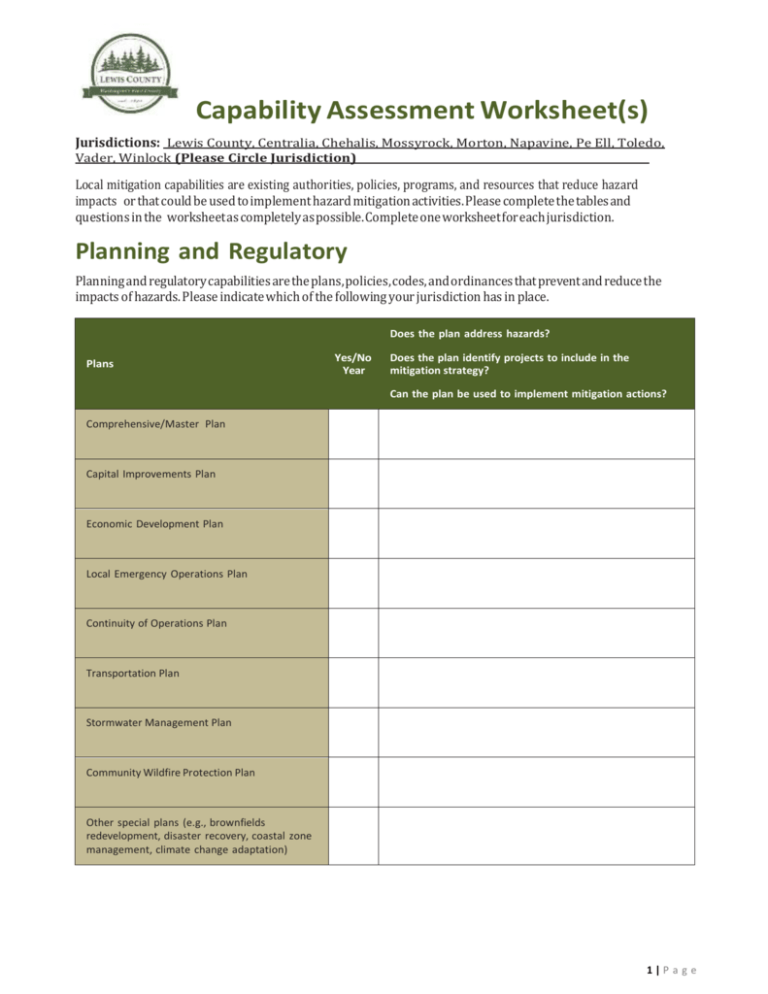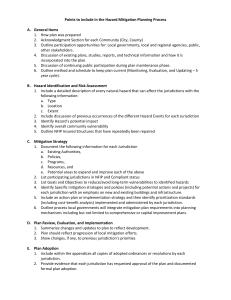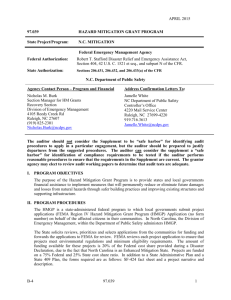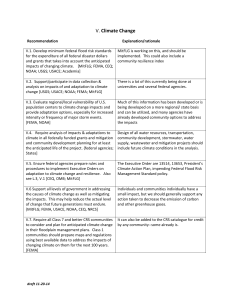Word - City of Centralia
advertisement

Worksheet 4.2 Safe Growth Audit Capability Assessment Worksheet(s) Jurisdictions: Lewis County, Centralia, Chehalis, Mossyrock, Morton, Napavine, Pe Ell, Toledo, Vader, Winlock (Please Circle Jurisdiction) Local mitigation capabilities are existing authorities, policies, programs, and resources that reduce hazard impacts or that could be used to implement hazard mitigation activities. Please complete the tables and questions in the worksheet as completely as possible. Complete one worksheet for each jurisdiction. Planning and Regulatory Planning and regulatory capabilities are the plans, policies, codes, and ordinances that prevent and reduce the impacts of hazards. Please indicate which of the following your jurisdiction has in place. Does the plan address hazards? Plans Yes/No Year Does the plan identify projects to include in the mitigation strategy? Can the plan be used to implement mitigation actions? Comprehensive/Master Plan Capital Improvements Plan Economic Development Plan Local Emergency Operations Plan Continuity of Operations Plan Transportation Plan Stormwater Management Plan Community Wildfire Protection Plan Other special plans (e.g., brownfields redevelopment, disaster recovery, coastal zone management, climate change adaptation) 1|P a g e Worksheet 4.2 Safe Growth Audit Building Code, Permitting, and Inspections Yes/No Are codes adequately enforced? Building Code Version/Year: Building Code Effectiveness Grading Schedule (BCEGS) Score Score: Fire department ISO rating Rating: Site plan review requirements Land Use Planning and Ordinances Yes/No Is the ordinance an effective measure for reducing hazard impacts? Is the ordinance adequately administered and enforced? Zoning ordinance Subdivision ordinance Floodplain ordinance Natural hazard specific ordinance (stormwater, steep slope, wildfire) Flood insurance rate maps Acquisition of land for open space and public recreation uses Other How can these capabilities be expanded and improved to reduce risk? 2|P a g e Worksheet 4.2 Safe Growth Audit Administrative and Technical Identify whether your community has the following administrative and technical capabilities.These include staff and their skills and tools that can be used for mitigation planning and to implement specific mitigation actions. For smaller jurisdictions without local staff resources, if there are public resources at the next higher level government that can provide technical assistance, indicate so in your comments. Describe capability Administration Yes/No Is coordination effective? Planning Commission Mitigation Planning Committee Maintenance programs to reduce risk (e.g., tree trimming, clearing drainage systems) Mutual aid agreements Is staffing adequate to enforce Staff Yes/No FT/PT1 regulations? Is staff trained on hazards and mitigation? Chief Building Official Is coordination between agencies and staff effective? Floodplain Administrator Emergency Manager Community Planner Civil Engineer GIS Coordinator Other 3|P a g e Worksheet 4.2 Safe Growth Audit Describe capability Technical Yes/No Has capability been used to assess/mitigate risk in the past? Warning systems/services (Reverse 911, outdoor warning signals) Hazard data and information Grant writing Hazus analysis Other How can these capabilities be expanded and improved to reduce risk? 4|P a g e Worksheet 4.2 Safe Growth Audit Financial Identify whether your jurisdiction has access to or is eligible to use the following funding resources for hazard mitigation. Funding Resource Access/ Eligibility (Yes/No) Has the funding resource been used in past and for what type of activities? Could the resource be used to fund future mitigation actions? Capital improvements project funding Authority to levy taxes for specific purposes Fees for water, sewer, gas, or electric services Impact fees for new development Storm water utility fee Incur debt through general obligation bonds and/or special tax bonds Incur debt through private activities Community Development Block Grant Other federal funding programs State funding programs Other How can these capabilities be expanded and improved to reduce risk? 5|P a g e Worksheet 4.2 Safe Growth Audit Education and Outreach Identify education and outreach programs and methods already in place that could be used to implement mitigation activities and communicate hazard-related information. Describe program/organization and how relates to disaster resilience and mitigation. Program/Organization Yes/No Could the program/organization help implement future mitigation activities? Local citizen groups or non-profit organizations focused on environmental protection, emergency preparedness, access and functional needs populations, etc. Ongoing public education or information program (e.g., responsible water use, fire safety, household preparedness, environmental education) Natural disaster or safety related school programs StormReady certification Firewise Communities certification Public-private partnership initiatives addressing disaster-related issues Other How can these capabilities be expanded and improved to reduce risk? 6|P a g e Worksheet 4.2 Safe Growth Audit Safe Growth Audit Use this worksheet to identify gaps in your community’s growth guidance instruments and improvements that could be made to reduce vulnerability to future development. Comprehensive Plan Yes No Land Use 1. Does the future land-use map clearly identify natural hazard areas? 2. Do the land-use policies discourage development or redevelopment within natural hazard areas? 3. Does the plan provide adequate space for expected future growth in areas located outside natural hazard areas? Transportation 1. Does the transportation plan limit access to hazard areas? 2. Is transportation policy used to guide growth to safe locations? 3. Are movement systems designed to function under disaster conditions (e.g., evacuation)? 7|P a g e Create an Outreach Strategy Worksheet 4.2 Safe Growth Audit Comprehensive Plan (continued) Yes No Environmental Management 1. Are environmental systems that protect development from hazards identified and mapped? 2. Do environmental policies maintain and restore protective ecosystems? 3. Do environmental policies provide incentives to development that is located outside protective ecosystems? Public Safety 1. Are the goals and policies of the comprehensive plan related to those of the FEMA Local Hazard Mitigation Plan? 2. Is safety explicitly included in the plan’s growth and development policies? 3. Does the monitoring and implementation section of the plan cover safe growth objectives? 8|P a g e Worksheet 4.2 Safe Growth Audit Zoning Ordinance Yes No Yes No 1. Does the zoning ordinance conform to the comprehensive plan in terms of discouraging development or redevelopment within natural hazard areas? 2. Does the ordinance contain natural hazard overlay zones that set conditions for land use within such zones? 3. Do rezoning procedures recognize natural hazard areas as limits on zoning changes that allow greater intensity or density of use? 4. Does the ordinance prohibit development within, or filling of, wetlands, floodways, and floodplains? Subdivision Regulations 1. Do the subdivision regulations restrict the subdivision of land within or adjacent to natural hazard areas? 2. Do the regulations provide for conservation subdivisions or cluster subdivisions in order to conserve environmental resources? 3. Do the regulations allow density transfers where hazard areas exist? 9|P a g e Worksheet 4.2 Safe Growth Audit Capital Improvement Program and Infrastructure Policies Yes No Yes No 1. Does the capital improvement program limit expenditures on projects that would encourage development in areas vulnerable to natural hazards? 2. Do infrastructure policies limit extension of existing facilities and services that would encourage development in areas vulnerable to natural hazards? 3. Does the capital improvement program provide funding for hazard mitigation projects identified in the FEMA Mitigation Plan? Other 1. Do small area or corridor plans recognize the need to avoid or mitigation natural hazards? 2. Does the building code contain provisions to strengthen or elevate construction to withstand hazard forces? 3. Do economic development or redevelopment strategies include provisions for mitigation natural hazards? 4. Is there an adopted evacuation and shelter plan to deal with emergencies from natural hazards? Questions adapted from Godschalk, David R. Practice Safe Growth Audits, Zoning Practice, Issue Number 10, October 2009, American Planning Association. http://www.planning.org/zoningpractice/open/pdf/oct09.pdf. 10 | P a g e National Flood Insurance Program (NFIP) Worksheet Use this worksheet to collect information on your community’s participation in and continued compliance with the NFIP, as well as identify areas for improvement that could be potential mitigation actions. Indicate the source of information, if different from the one included. NFIP Topic Source of Information Comments Insurance Summary How many NFIP policies are in the community? What is the total premium and coverage? State NFIP Coordinator or FEMA NFIP Specialist How many claims have been paid in the community? What is the total amount of paid claims? How many of the claims were for substantial damage? FEMA NFIP or Insurance Specialist How many structures are exposed to flood risk within the community? Community Floodplain Administrator (FPA) Describe any areas of flood risk with limited NFIP policy coverage Community FPA and FEMA Insurance Specialist Staff Resources Is the Community FPA or NFIP Coordinator certified? Community FPA Is floodplain management an auxiliary function? Community FPA Provide an explanation of NFIP administration services (e.g., permit review, GIS, education or outreach, inspections, engineering capability) Community FPA What are the barriers to running an effective NFIP program in the community, if any? Community FPA Compliance History Is the community in good standing with the NFIP? State NFIP Coordinator, FEMA NFIP Specialist, community records Are there any outstanding compliance issues (i.e., current violations)? When was the most recent Community Assistance Visit (CAV) or Community Assistance Contact (CAC)? Is a CAV or CAC scheduled or needed? 11 | P a g e NFIP Topic Regulation Create an Outreach Strategy When did the community enter the NFIP? Source of Information Comments Community Status Book http://www.fema.gov/ national-flood-insuranceprogram/national-floodinsurance-programcommunity-status-book Are the FIRMs digital or paper? Community FPA Do floodplain development regulations meet or exceed FEMA or State minimum requirements? If so, in what ways? Community FPA Provide an explanation of the permitting process. Community FPA, State, FEMA NFIP Flood Insurance Manual http://www.fema.gov/ flood-insurance-manual Community FPA, FEMA CRS Coordinator, ISO representative CRS manual http:// www.fema.gov/library/ viewRecord.do?id=2434 Community Rating System (CRS) Does the community participate in CRS? Community FPA, State, FEMA NFIP What is the community’s CRS Class Ranking? Flood Insurance Manual http://www.fema.gov/ flood-insurance-manual What categories and activities provide CRS points and how can the class be improved? Does the plan include CRS planning requirements Community FPA, FEMA CRS Coordinator, ISO representative CRS manual http:// www.fema.gov/library/ viewRecord.do?id=2434 12 | P a g e






